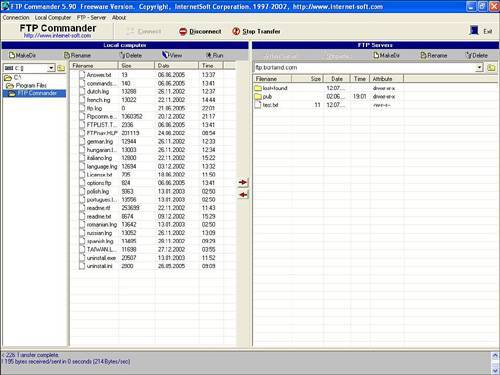Using FTP
| The File Transfer Protocol, or FTP, is one of the basic protocols used by Internet software. It allows large files to be moved around on the Internet without the necessity for the sort of excess baggage required by HTML or email protocols. The odds are good that you'll use FTP to move your podcast to the websitethe only question is whether you have to know about FTP. Many of the services of the sort we'll talk about later in this chapter hide all the FTP details from the user. If you do have to use a basic FTP program to send your files, you'll find that it's not complicated as long as you know a couple of things about the server to which you're sending. There are a number of shareware or free FTP clients (that's the software that sits on your computer) available, and all work in pretty much the same way. Figure 8.19 shows one of the clients available for Windows, FTP Commander. In this screen shot, we've connected to a basic FTP server, and you can see the files on our local computer on the left, the remote FTP server on the right, and arrows that command files to be moved from one to the other in the middle of the screen. Figure 8.19. An FTP client helps move large files on the Internet. The first question to be answered is whether the site you'll be uploading to accepts "anonymous" FTP. That means it doesn't require any sort of user name or password from someone who wants to send a file. To reach a server that supports anonymous FTP, all you need to know is the address of the server, which will likely be ftp.something.com. Figure 8.20 shows the dialog box in which you set up the information to reach a new server. Notice that there's a check box for anonymous FTPthis is a very common way of doing things. Figure 8.20. Anonymous login requires a simple check box in the client. Because FTP is a service that is part of most operating systems, and the location for the files is not included in these basic services as it might be when FTP is part of an application or dedicated podcasting service, you may need to know which directory your file will go into when you place it on the server. You will generally get to the necessary directory on the server the same way you get to the right directory on your computer, with pointing and double-clicking. As you begin to work with FTP, there are only a few things that you might need to know in order to fill in the necessary boxes in a dialog box:
Of course, choosing the right service to host or support your podcast can make knowledge of FTP services unnecessary, as they take care of all the gritty details and smooth your way to a published podcast. |
EAN: N/A
Pages: 167